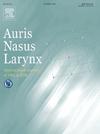7例喉舌全切联合下颌骨切除术:来自单一机构的回顾性病例系列
IF 1.5
4区 医学
Q2 OTORHINOLARYNGOLOGY
引用次数: 0
摘要
目的舌癌、龈癌、舌底癌合并下颌骨肿瘤侵袭的病例,可能需要进行全喉舌切除术和下颌骨切除术。但是,由于此类病例数量有限,因此报告的病例很少。本研究旨在探讨喉舌全切联合下颌骨切除术的治疗策略。方法本研究纳入2014年1月至2023年12月间行根治性手术包括全喉舌切除联合部分下颌骨切除术的头颈癌患者。我们调查了患者的性别、年龄、原发病灶位置、肿瘤-淋巴结-转移分类、放射暴露史、术前/术后治疗、手术切除和重建方法、颈部清扫程度、手术时间、出血量、围手术期并发症、术后恢复口服时间、住院时间、随访观察时间和结局。结果7例患者行喉舌全切联合下颌骨部分切除术。手术时的中位年龄为57岁(6男1女)。四名患者患有口底癌,两名患有牙龈癌,一名患有涉及舌头和下咽的双重原发性癌症。两名患者有其他头颈部癌症的放射治疗史。5例患者接受多西紫杉醇、顺铂、氟尿嘧啶诱导化疗,4例患者术后接受顺铂放化疗。4例患者肿瘤直接侵袭,需要同时切除面部皮肤。在未接受头颈部放射治疗的患者中,5例患者行双侧颈清扫(I-IV),其余患者仅行患侧颈清扫。所有患者的重建包括游离腹直肌皮瓣和钛下颌骨重建板。2例患者因缝线破裂而发生严重渗漏,均经负压创面治疗后恢复。术后恢复口服进食的中位时间为12.5天,中位住院时间为38天。中位随访期为26个月,其中4例患者无疾病,1例复发,2例死于原发疾病。结论通过适当的治疗,即使在喉舌全切联合下颌骨部分切除术的情况下,患者也能长期存活。此外,为了方便治疗后的口服摄入,在大量病例中,对重建方法、材料和形式进行全面评估是至关重要的。本文章由计算机程序翻译,如有差异,请以英文原文为准。
Seven cases of total laryngo-glossectomy combined with mandibulectomy: A retrospective case series from a single institution
Objective
In cases of tongue, gingival, or base of tongue cancer with mandibular tumor invasion, total laryngo-glossectomy and mandibulectomy may be necessary. However, since such cases are limited in number, very few cases have been reported. This study aimed to investigate the treatment strategy involving total laryngo-glossectomy combined with mandibulectomy.
Methods
This study included patients with head and neck cancer who underwent radical surgery involving total laryngo-glossectomy combined with partial mandibulectomy between January 2014 and December 2023. We investigated the sex, age, primary lesion location, tumor-node-metastasis classification, history of radiation exposure, preoperative/postoperative treatments, surgical methods for resection and reconstruction, extent of neck dissection, surgical duration, blood loss volume, perioperative complications, time to resume oral intake post-surgery, length of hospital stay, duration of follow-up observation, and outcomes.
Results
Seven patients who underwent total laryngo-glossectomy combined with partial mandibulectomy were included in this study. The median age at the time of surgery was 57 years (six males and one female). Four patients had floor of the mouth cancer, two had gingival cancer, and one had dual primary cancer involving the tongue and hypopharynx. Two patients had a history of radiation therapy for other head and neck cancers. Five patients received induction chemotherapy with docetaxel, cisplatin, and fluorouracil, and four patients received postoperative chemoradiotherapy with cisplatin. Four patients had direct tumor invasion necessitating concurrent resection of the facial skin. Among the patients without prior radiation therapy to the head and neck region, five underwent bilateral neck dissection (I–IV), whereas the remaining patients underwent neck dissection on the affected side only. Reconstruction in all patients involved the free rectus abdominis musculocutaneous flap and a titanium mandibular reconstruction plate. Two patients experienced major leakage owing to suture rupture, and both recovered following negative pressure wound therapy. The median time to resumption of oral intake after surgery was 12.5 days, and the median hospital stay was 38 days. The median follow-up period was 26 months, with four patients remaining disease-free, one experiencing recurrence, and two succumbing to their primary disease.
Conclusion
Long-term survival can be anticipated with appropriate treatment, even in cases of total laryngo-glossectomy combined with partial mandibulectomy. In addition, to facilitate post-treatment oral intake, it is crucial to thoroughly evaluate the reconstruction methods, materials, and forms in a larger number of cases.
求助全文
通过发布文献求助,成功后即可免费获取论文全文。
去求助
来源期刊

Auris Nasus Larynx
医学-耳鼻喉科学
CiteScore
3.40
自引率
5.90%
发文量
169
审稿时长
30 days
期刊介绍:
The international journal Auris Nasus Larynx provides the opportunity for rapid, carefully reviewed publications concerning the fundamental and clinical aspects of otorhinolaryngology and related fields. This includes otology, neurotology, bronchoesophagology, laryngology, rhinology, allergology, head and neck medicine and oncologic surgery, maxillofacial and plastic surgery, audiology, speech science.
Original papers, short communications and original case reports can be submitted. Reviews on recent developments are invited regularly and Letters to the Editor commenting on papers or any aspect of Auris Nasus Larynx are welcomed.
Founded in 1973 and previously published by the Society for Promotion of International Otorhinolaryngology, the journal is now the official English-language journal of the Oto-Rhino-Laryngological Society of Japan, Inc. The aim of its new international Editorial Board is to make Auris Nasus Larynx an international forum for high quality research and clinical sciences.
 求助内容:
求助内容: 应助结果提醒方式:
应助结果提醒方式:


